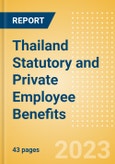The report provides in-depth industry analysis, information, and insights of the employee benefits in Thailand, including an overview of the state and compulsory benefits in Thailand, detailed information about the private benefits in Thailand, insights on various central institutions responsible for the administration of the different branches of social security and the regulatory framework of the employee benefits in Thailand.
Both employees and employers fund Thailand’s social security system. Old age, disability, survivors, sickness and maternity benefits, and family allowances are offered under voluntary cover for self-employed persons and individuals with at least 12 months of compulsory cover who then cease to be covered. Thai citizens working abroad and self-employed persons are not covered by unemployment or work injury benefits. The Labor Relations Act is responsible for the provision of severance pay, sick leave, paid vacation, statutory holidays, and terms of employment.
The workmen’s compensation insurance provides benefits when there is an occupational injury, illness, or death of an insured. The Thai pension system is divided into four pillars: the first pillar or state pension consists of the Social Security Fund (SSF) and Old Civil Service Scheme (OCSS) to secure basic needs, the second pillar consists of the Government Pension Fund (GPF) and the National Saving Fund (NSF), and the third pillar is voluntary and privately financed personal provision which provides benefits through the Provident Fund, the Retirement Mutual Fund, and the National Savings Fund. Private employee benefits are also gaining prominence in Thailand.
The current Thai retirement system has a good foundation for an adequate and sustainable retirement system in the medium and long term. However, the country is facing a rapidly aging population and a continuously changing labor market that calls for a review of the retirement system. A report by International Labour Organization, U.N. Joint Programme on Social Protection for All in Thailand, commented on avoiding the introduction of new pension schemes and lump sum withdrawals by members for the long-term sustainability of the retirement system.
Both employees and employers fund Thailand’s social security system. Old age, disability, survivors, sickness and maternity benefits, and family allowances are offered under voluntary cover for self-employed persons and individuals with at least 12 months of compulsory cover who then cease to be covered. Thai citizens working abroad and self-employed persons are not covered by unemployment or work injury benefits. The Labor Relations Act is responsible for the provision of severance pay, sick leave, paid vacation, statutory holidays, and terms of employment.
The workmen’s compensation insurance provides benefits when there is an occupational injury, illness, or death of an insured. The Thai pension system is divided into four pillars: the first pillar or state pension consists of the Social Security Fund (SSF) and Old Civil Service Scheme (OCSS) to secure basic needs, the second pillar consists of the Government Pension Fund (GPF) and the National Saving Fund (NSF), and the third pillar is voluntary and privately financed personal provision which provides benefits through the Provident Fund, the Retirement Mutual Fund, and the National Savings Fund. Private employee benefits are also gaining prominence in Thailand.
The current Thai retirement system has a good foundation for an adequate and sustainable retirement system in the medium and long term. However, the country is facing a rapidly aging population and a continuously changing labor market that calls for a review of the retirement system. A report by International Labour Organization, U.N. Joint Programme on Social Protection for All in Thailand, commented on avoiding the introduction of new pension schemes and lump sum withdrawals by members for the long-term sustainability of the retirement system.
Key Highlights
- The Ministry of Labor (MOL), and Social Security Office (SSO) organizations are responsible for the functioning of the overall social security system
- A person’s national insurance contribution is determined based on their income
- An insured person who is unemployed or unable to work and whose benefits have been exhausted is entitled to a credited contribution
- In Thailand, employers provide voluntary retirement benefits to their employees through provident funds
Scope
This report provides a detailed analysis of employee benefits in Thailand:
- It offers a detailed analysis of the key government-sponsored employee benefits, along with private benefits
- It covers an exhaustive list of employee benefits, including retirement benefits, death in service, long-term disability benefits, medical benefits, workmen's compensation insurance, maternity and paternity benefits, family benefits, unemployment, leaves and holidays, and private benefits
- It highlights the economic and regulatory situations relating to employee benefits in Thailand
Reasons to Buy
- Make strategic decisions using in-depth information related to employee benefits in the country
- Assess employee benefits of the market, including state and compulsory benefits and private benefits
- Gain insights into the key employee benefit schemes offered by private employers in the country
- Gain insights into key organizations governing employee benefits market, and their impact on companies
Table of Contents
1. Executive Summary3. Country Statistics4. Overview of Employee Benefits in Thailand5. Regulations
2. Introduction
6. State and Compulsory Benefits
7. Private Benefits
List of Tables








